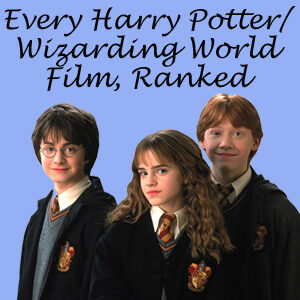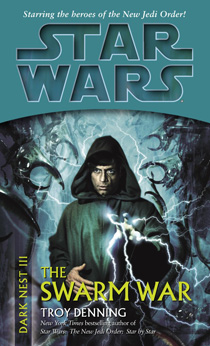Troy Denning wraps up his bridge trilogy between “The New Jedi Order” and “Legacy of the Force” in mostly satisfying fashion with “Dark Nest III: The Swarm War” (2006). But the reader doesn’t get a sense of completeness; threads such as Jacen’s interest in power and the fates of Alema Rar and Jag Fel are deferred to future stories.
In a notable change from the detail Denning went into back in trilogy-opening “The Joiner King” – particularly in regard to Jaina and Zekk being Joiners, and the way the Killiks’ collective mind operates – “The Swarm War” leaves a lot of stones unturned, even though it resolves the Chiss vs. Killik war in a tidy bow. Jaina and Zekk just kind of gradually depart from the collective mind, so there’s no big intervention scene where they have to be brought back into the Jedi Order. Raynar Thul is not so lucky; in a throwaway line, we learn that the Jedi hook him up to what is essentially a shock collar for his brain to break him of his Killik connection.
Perhaps to keep the book at a manageable 357 pages, “The Swarm War” defers a lot of conflicts, necessary conversations and mysteries. It occurs to me that we never see the perspective of the bad guys throughout the whole trilogy; while this is the opposite of the approach of some great novels – for example, the Thrawn trilogy features a back-and-forth between the opposing sides’ points of view – it adds an effectively unnerving undertone to “Dark Nest.” Villains such as Alema and Lomi Plo could’ve been cartoonish if we saw their POV; instead, they’re compelling hurdles who must be overcome by our heroes.
Fallen Jedi Knight Alema is the opponent whom Leia must overcome in order to become a Jedi Knight herself, while the former Nightsister Lomi Plo is fascinating for her powers – she hides behind her opponent’s doubts and fears – and her mysterious nature – human but with Killik implants and appendages, she doesn’t speak a word through the entire trilogy. In both cases, Denning is playing with the Lucasian trope of a villain becoming less redeemable as they become less physically human. Over the course of the trilogy, Alema – initially a perfect specimen of Twi’lek beauty — loses the function in one arm, plus part of a lekku and part of a foot in battles with Luke and Leia.
In the second book, “The Unseen Queen,” Jaina vows she’ll never fly with her brother again, but we don’t get a followup to this conflict in the third book; the sibling spat will be picked up in “Legacy of the Force.” The Jaina-Jag clash feels somewhat underplayed, too. The former lovers are regretfully willing to shoot the other down in the course of the Killik-Chiss war, and there’s a palpable sense of tragedy to that, but not a lot of specifics to help us understand how either of them could put their nationalistic loyalties above their love.

The broad explanation is that Jaina is controlled by the collective and a desire to prevent speciescide, whereas Jag is understandably angry that the Jedi broke their word regarding Lowbacca’s release. When Jag released Lowbacca in “The Unseen Queen,” it was in exchange for a promise that the Wookiee would sit out the rest of the war; but he did not. Off-page, Lowbacca participated in missions that harmed the Chiss.
Speaking of Jedi behaving in questionable fashion, we have to bring up Jacen, who has now completed his 180-degree shift in thought from early in the “NJO,” when he felt an indecisive but powerful person such as himself should refrain from taking sides in a war, lest he create more problems. In “The Unseen Queen,” his decision to preemptively attack the Chiss – based on a Force vision – ignites the war. But he feels no remorse for that faulty decision in “The Swarm War.” It’s enough for him that he made the decision and took action.
Throughout the trilogy, Luke, Mara and Jacen view Artoo’s holograms of Anakin Skywalker’s fall to the dark side, including key moments such as his massacre of younglings, his choking of Padme and the start of his lightsaber duel with Obi-Wan. Luke is rightfully horrified by these images, but Jacen goes down a different mental path, as we see on page 185:
Jacen found himself responding to his grandfather far more sympathetically. Anakin Skywalker understood his own strength, and – at one time, at least – had attempted to use that strength to bring peace. Vergere would have approved. Power unused was power wasted, and whatever happened to him later, Anakin Skywalker had at least attempted to use his for a good end.
The way Jacen’s journey parallels Anakin Skywalker’s is arguably a bit blunt. Jacen is influenced by visions and the desire to protect Tenel Ka – essentially his secret wife – and Allana, his secret daughter. What’s different is that Jacen isn’t driven by anger, but rather by an internal logic. The fact that he can make excuses for Anakin is unnerving (Anakin always had twisted ideas of “peace,” and Jacen should be smarter), but as I go into my “Legacy of the Force” re-read, I’ll be latching onto Jacen’s thought process to see where he differs from his grandfather in notable ways. Perhaps his fall to the dark side isn’t as clichéd and frustrating as I remember it from my first read.
We don’t see Luke discuss Artoo’s holograms with Leia, just as we don’t get scenes of Leia discussing Shmi’s journals with Luke in “Tatooine Ghost.” Perhaps these conversations take place off-page, but I think it would have been interesting to see brother and sister discuss their family heritage. Or maybe they don’t discuss their findings about their ancestors. Luke doesn’t want to talk about Darth Vader with Leia in “Return of the Jedi,” and Leia doesn’t want to talk about Vader in “The Truce at Bakura.” Although the siblings are close in some ways – Leia’s love brings Luke back from the dark side in “Dark Empire” – maybe they don’t communicate well.
It’s interesting to note that in the “Dark Nest” trilogy, Leia develops Luke’s primary aspect (becoming a Jedi warrior) and Luke develops Leia’s main skill (diplomacy, as he declares himself the Grand Master of the Jedi Order, brokering discussion but not tolerating dissent). However, Leia is trained by Saba Sebatyne and Luke gets his guidance from his wife, Mara, and a bit from Jacen, who correctly notes that Luke can’t battle Lomi until he has come to terms with what he’s seen in the holos of his father.
Tonally, “Dark Nest” has shifted the “Star Wars” EU from a sense of unified purpose in the Yuuzhan Vong war to a sense of looming civil war. While our heroes put an end to the Chiss-Killik war, and treaties are signed and overtures are made, the galaxy is not politically stable. Indeed, Galactic Alliance Chief of State Cal Omas sells out Han and Leia at one point in “The Swarm War,” nearly getting them killed. And then there’s the rift between the Solos and Fels.
By and large, the fact that Denning leaves a lot of things off-page isn’t a big deal, as it’s just fodder for “Legacy of the Force.” Still, I was a bit disappointed that we didn’t get more definitive information about the Killiks’ history. On page 344, Luke surmises that the Celestials (to be later explored in “The Clone Wars’ ” famous “Mortis” trilogy and Denning’s “Fate of the Jedi: Apocalypse”) forced the Killiks off Alderaan and into the Unknown Regions as a way of stopping the insectoid species’ uncontrolled population boom. The concept of the Killiks building Centerpoint Station and the Maw peters out when Luke, on page 308, notes that this species shows no inclination for such technology and that the claims of collective minds can get jumbled. (For the record, the Celestials created Centerpoint and the Maw, as we learned in reference books such as “The Essential Atlas” and “The Essential Guide to Warfare.”)
One particular unexplained moment is rather annoying, though. As she’s being interrogated by the Chiss, Leia sees on a video feed that Han is being tortured; he even gets an ear cut off! After she escapes, she finds to her surprise that Han is unscathed. The mystery of how the Chiss faked out Leia with the torture scene is completely unremarked on from that point forward. Perhaps I missed an implication about what was really going on, but it seems this scene is part of a larger problem of dropped or underexplored notions in “The Swarm War.”
Jae Juun’s Ewok first mate, Tarfang, is another example. It seems that Tarfang is a rare Ewok who desires a life of adventure off of Endor, yet Leia’s Noghri bodyguards disguise themselves as Ewoks at one point – this is not a good way to blend in, unless Ewoks have indeed started to spread out from Endor to the point where a couple of Ewok crewmen is not an unusual sight. Yet it certainly should be, to judge by the EU’s overall portrayal of Ewoks.
“The Swarm War” is a page-turning journey with a conclusion to the “Dark Nest” plot, but certainly not to the character arcs, political conflicts or galactic mysteries. For those, I’ll have to dive into “Legacy of the Force.” That’s not such a bad thing, though.

